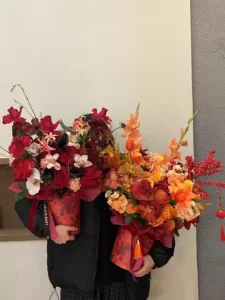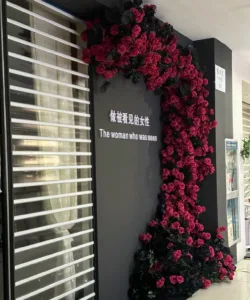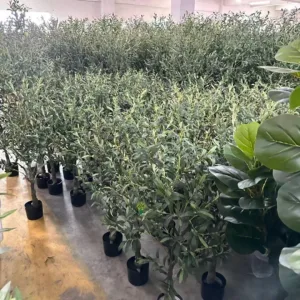yes ,beautiful faux flowers that look real usually cost more than their fresh counterparts
In the realm of floral aesthetics, the allure of both artificial and real flowers is undeniable. Each has its distinct charm, but today we embark on a journey to uncover the surprising truth: Which holds the greater value, artificial flowers or their living counterparts? Delve into this exploration as we consider several key aspects and provide a unique and professional perspective.
How much does the average fake flower cost?
After checked with several big shop online like AMAZON, HOME DEPT, WALMAT, we find the price comparison of several flowers type as below :
| Artificial /Fake | Real/Fresh | |
| Orchid | 12.99USD -699USD | 7.97USD-503USD |
| Rose | 4.9USD-20.99USD | 5.18USD-174USD |
| Tulips | 0.68USD-499USD | 0.9USD-220.99USD |
| Lily | 2.08USD-648.13USD | 2.08USD-595.99USD |
| Sunflowers | 1.58USD-126USD | 1.54USD-`169USD |
From Above Table, we can see that for high quality artificial flowers ,the cost mostly higher than fresh flower.
Why Artificial Flowers more expensive than Fresh Flowers?
It’s important to note that the price of artificial flowers can vary significantly depending on factors such as brand reputation, quality, craftsmanship, and design complexity.
Quality and Realism
High-quality artificial flowers are designed to closely mimic the appearance and texture of real flowers.
Achieving this level of realism requires skilled craftsmanship, attention to detail, and the use of premium materials. The cost of sourcing or creating these materials, along with the expertise required for intricate designs, can contribute to the higher price tag.
Materials and Manufacturing
The cost of materials used in artificial flowers, such as silk, polyester, or specialized plastics, can vary depending on their quality and availability. Additionally, the manufacturing process for artificial flowers often involves intricate steps, including molding, coloring, assembly, and finishing touches, which require specialized equipment and skilled labor. These factors can increase the production costs, resulting in higher prices for the end product.
Labor Intensive Production
Crafting high-quality artificial flowers often involves intricate and labor-intensive processes. Skilled artisans or craftsmen are required to shape, assemble, and hand-finish each flower with meticulous attention to detail. The time and effort invested in creating lifelike artificial flowers contribute to their higher cost.
Customization and Design
Artificial flowers offer the advantage of customization and tailored designs to suit specific preferences or requirements.
Customizing artificial flowers involves additional labor and expertise, which can add to the overall cost. Similarly, unique or intricate designs may require more time and effort, impacting the price of the final product.
Design Innovation and Uniqueness
Artificial flowers offer a wide range of design possibilities that allow for creativity and uniqueness. Designers and manufacturers continually strive to innovate and create new and captivating designs to meet evolving consumer preferences. The investment in research and development, as well as the exclusivity of certain designs, can drive up the price of artificial flowers that offer distinctive aesthetics or artistic value

What’s the material of artificial flower
Artificial flowers can be made from various materials to achieve different levels of realism and durability. Here are several common materials used in the production of artificial flowers:
- Polyester: Polyester is a popular material for creating artificial flowers due to its flexibility and ability to hold vibrant colors. It can be easily molded and shaped into different flower forms, making it suitable for a wide range of floral designs.
- Silk: Silk fabric is another common material used in artificial flowers. It is known for its soft and natural texture, closely resembling the delicate petals of real flowers. Silk flowers often exhibit a high level of detail and are favored for their elegance and realism.
- Plastic: Plastic is a versatile material that allows for the creation of durable and long-lasting artificial flowers. It can be molded into various shapes and colors, making it ideal for replicating different flower varieties. Plastic flowers are often chosen for their affordability and resistance to fading or wilting.
- Foam: Foam, particularly polyurethane foam, is used to create realistic artificial flower components such as petals and leaves. It can be shaped and painted to mimic the texture and appearance of real flowers, providing a lifelike feel.
- Paper: Paper flowers are crafted using different types of paper, including crepe paper, tissue paper, and cardstock. These delicate creations can be meticulously handcrafted to resemble real flowers, showcasing intricate details and textures.
- Latex: Latex is sometimes used to create artificial flowers, especially for achieving a more natural and realistic look. Latex flowers can mimic the softness and pliability of real petals, providing a tactile experience similar to real flowers.
It’s worth noting that manufacturers may combine these materials or incorporate additional elements to enhance the realism and durability of artificial flowers. The choice of material often depends on the desired appearance, durability requirements, and budget considerations for the specific artificial flower design.
Among the materials commonly used in artificial flowers, some are more environmentally friendly than others. Here are a few environmentally conscious options which cost also much higher:
- .Natural and Sustainable Fabrics: Some artificial flowers are crafted from natural and sustainable fabrics such as organic cotton, hemp, or bamboo. Like our bamboo tree plant, the main pole ,we choose real bamboo, These materials are biodegradable and have a lower environmental impact compared to synthetic options. However, it’s essential to ensure that the dyes and treatments used in the fabrication process are also eco-friendly.
- Recycled Materials: Artificial flowers made from recycled materials contribute to waste reduction and resource conservation. Recycled plastic, for example, can be transformed into artificial flower components, minimizing the need for virgin plastic production. Look for products explicitly labeled as using recycled materials.
- Natural Fiber Papers: Artificial flowers crafted from natural fiber papers, such as recycled or handmade paper, can be more eco-friendly than synthetic options. These papers are often biodegradable and can be sourced from sustainable forestry practices.
- Biodegradable Plastics: While most artificial flowers are made from traditional plastics, some manufacturers have started producing biodegradable or compostable plastic alternatives. These plastics break down more easily and reduce long-term environmental impact compared to non-biodegradable counterparts. Look for products specifically labeled as biodegradable or compostable.
What’s the advantages of artificial flowers
There are 5 advantages of artificial flowers as below :
Long Lifespan and Durability:
Artificial flowers exhibit an exceptional advantage in terms of longevity and resilience. Unlike real flowers, which have a limited lifespan, artificial blooms can grace your surroundings indefinitely, retaining their pristine appearance. The upfront investment in artificial flowers can be deemed more cost-effective in the long run, as they require no ongoing care or replacement.
Without Seasonality and Availability
Real flowers are highly influenced by seasonal variations and geographical limitations. Rare or exotic blooms may come at exorbitant prices due to cultivation challenges and transportation costs. On the other hand, artificial flowers overcome these obstacles by transcending seasons and geographical boundaries. They offer a wide array of choices, including elusive and delicate species, ensuring that your desired floral arrangements are within reach regardless of the time of year.
Low Maintenance and Cost-efficiency
Real flowers demand meticulous care, including watering, pruning, and protecting them from adverse conditions. Additionally, they have a limited lifespan, necessitating frequent replacement. Artificial flowers, in contrast, require minimal maintenance. Once arranged to perfection, they retain their flawless beauty without the need for water, sunlight, or costly care routines. This durability makes artificial flowers a cost-efficient choice, sparing you recurring expenses associated with real flowers.
Less Pesticides and Carbon-intensive for Environmental Impact
Sustainability and environmental consciousness are increasingly prominent concerns. Here, artificial flowers present a compelling case. While real flowers have a short lifespan and contribute to waste generation, artificial flowers are crafted from durable materials that can be reused and repurposed. Opting for artificial flowers reduces the demand for horticultural practices that may involve pesticides, excessive water consumption, and carbon-intensive transportation.
Artistic Expression and Customization
Artificial flowers provide limitless artistic possibilities and customization options. Crafted with meticulous attention to detail, they can emulate the finest intricacies of real flowers or even transcend natural boundaries with imaginative designs. This flexibility allows for tailored creations, enabling you to express your unique vision and style. Real flowers, while inherently beautiful, are limited by nature’s palette and the constraints of seasonal availability.

Conclusion: After a comprehensive exploration of the facets that determine value, it becomes evident that artificial flowers possess a unique allure and undeniable advantages over their living counterparts. With their enduring beauty, cost-effectiveness, year-round availability, and minimal maintenance requirements, artificial flowers emerge as a distinct and valuable choice for those seeking to infuse lasting elegance into their surroundings.
Disclaimer: This article presents a perspective favoring artificial flowers based on their unique qualities and benefits. It is important to consider personal preferences, cultural significance, and individual contexts when making choices between artificial and real flowers.
.jpg)




